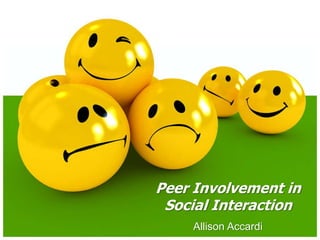
Peer Involvement in Social Interaction
- 1. Peer Involvement in Social Interaction Allison Accardi
- 2. Importance of First Year of Life Social competence begins to develop in children as early as the first year of life During the first year of life, infants peer interaction is quite limited The limitation, however, does not mean social competence is not being acquired Interaction and manipulation of objects Looking intently at family members/caregivers
- 3. Patterns in Early School Years Interactions between peers become more evident in early school years Patterns of peer interaction becomes more standardized Social tendencies of early school aged children serve as predictors of future social competence and function, academic ability, and overall mental health
- 6. Contributions to Young Children’s Socialization In home and outside of home child care environmental experiences influence development of social skills Strong factors in variance of evidence include: Family demographics Income Maternal Education Outside of home caregiver training Size of care group (number of children) Caregiver to child ratio
- 7. Social and emotional competencies of young children have been attributed to interaction with adults Parents and caregivers directly influence the interaction course between peers in young children Adults become involved in young children’s resolution of conflicts Adults obstruct interactions by individually interacting with young children Adult Interaction
- 8. Investigation of Patterns of Socialization in Infants in Toddlers The period of infancy and toddlerhood represents a unique period of development in peer competence Findings suggest that negative or aggressive behavior when infants and toddlers interact include factors differing from those of older children Factors include Peer sociability Active avoidance of peers Passive withdrawal from peer interaction This pattern implies that aggression and some types of negative behavior may represent other outcomes when surveyed in infant and toddler years Aggression and negative behavior is an adaptive behavior in the very young years and may not always be an indicator of maladaptive social competence
- 9. Infant and Toddler Behavior Current findings suggest that these aggressive and negative behaviors represent early signs of peer sociability, avoidance, and refusal (Williams, et. al., 2006) Taking other’s toys Indicator for sociability Hitting, biting, or otherwise hurting other children Indicator for active avoidance strategies Crying easily around other children Indicator of other avoidance strategy In sum, certain behaviors typically considered aggressive or negative, and indicative of poor social competence across childhood (Campbell et al., 2000; Howes, 1988; NICHD ECCRN, 2001; for a review see Odom & Ogawa, 1992), may signify normative attempts to interact with peers, or to refuse and avoid social interaction, in infancy and toddlerhood
- 10. Socioeconomic Status (SES) Research has found that children from families of higher socioeconomic status (SES) have tested to demonstrate higher levels of peer refusals in some contexts This unexpected finding may be attributed to families of advanced SES have a tendency to regulate the actions of their children and playmates For example, “play dates” are arranged by parents thus play time becomes more structured Peer interactions then become controlled by adult contact However, recent work suggests that family SES may relate differently to children’s social competence in classrooms or schools than it does in other settings (Schneider, Richard, Younger, & Freeman, 2000)
- 11. Summary Research has shown that negative and aggressive interactive behavior in infancy and toddlerhood does not characterize an exclusive aspect of social competence Rather patterns of peer interaction can be characterized by: sociability with peers active refusal of peer interaction passive avoidance of interaction with peers Each of these three dimensions of peer competence appears to demonstrate its own developmental antecedents. Peer sociability is attributed to caregiver disruption of peer interaction Active peer refusal and passive peer avoidance are more narrowly coupled to individual temperament of a child Active peer refusal can also be accounted for, in part, by the child’s family socioeconomic status
- 12. References Biovin, M., Vitaro, F., & Poulin, F. (2005). Peer relationships and the development of aggressive behavior in early childhood. In R. E. Tremblay, W.W. Hartup& J. Archer (Eds.), Developmental origins of aggression. New York, NY: The Guilford Press. Campbell, J. J., Lamb, M. E., & Hwang, C. P. (2000). Early child-care experiences and children’s social competence between 1 1/2 and 15 years of age. Applied Developmental Science, 4, 166–175. Howes. (1988). Peer interaction in young children. Monographs of the Society for Research in Child Development, 53. NICHD Early Child Care Research Network. (2001). Child care and children’s peer interaction at 24 and 36 months: The NICHD study of early child care. Child Development, 72, 1478– 1500. Odom, S. L., & Ogawa, I. (1992). Direct observation of young children’s social interaction with peers: A review of methodology. Behavioral Assessment, 14, 407–441. Schneider, B., Richard, J., Younger, A., & Freeman, P. (2000). A longitudinal exploration of children’s social participation and social withdrawal across socioeconomic status levels and social settings. European Journal of Social Psychology, 30, 497–519. Williams, S. T., Ontai, L.L., & Mastergeorge, A.M. (2006). Reformulating infant and toddler social competence with peers. Infant Behavior & Development 30 (2007) 353–365.